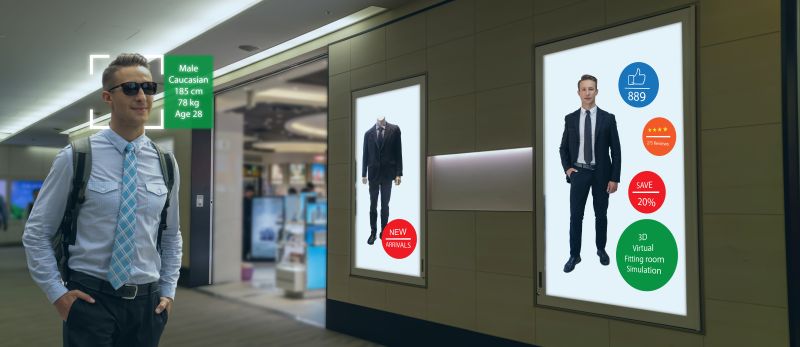A screen that changes its content because it knows stock is running low. A menu that updates automatically depending on the time of day and real demand. A storefront display that adapts its message after detecting that most passers-by are families with children. All of this is possible today. And yet, among the world’s biggest brands, the use of artificial intelligence in digital signage is progressing far more slowly than expected.
AI is no longer experimental. While debates about its impact on productivity continue, in many industries it already automates processes, personalizes experiences and makes real-time decisions. In digital signage, its clearest applications are content creation, data analysis and campaign optimization.
The problem is that many brands remain stuck in pilot mode. They launch promising tests, but only in a handful of locations and with no plan to scale. The result is a missed opportunity to turn AI into a structural pillar of their communication strategy.
Because this is not about having “smarter screens.” It’s about using AI to make every customer touchpoint more relevant, faster and more aligned with what the brand wants to communicate.
For a global retailer, AI can dynamically update messages based on location, weather, time of day or the audience standing in front of the display. In quick-service restaurants, it can adjust prices and menus on the fly based on inventory and sales forecasts. In fashion, it can synchronize online and in-store campaigns so that customers receive a consistent, context-aware message across every channel.
Learning From Early Adopters
Some global brands have already taken meaningful steps. IKEA, for example, has implemented systems that allow hundreds of screens across multiple countries to be centrally managed and updated almost instantly. It’s not just about showing one message in the restaurant area and another at checkout — it’s about feeding those messages with live data: stock levels, active promotions, customer behavior.
This reduces reaction times and creates a more coherent experience. Customers no longer see generic content; they see something that aligns with what they’re looking for in that specific moment and place.
What’s Really Slowing AI + Digital Signage Adoption
The barrier isn’t technology. Algorithms, sensors and platforms are already available. The real obstacles tend to be internal culture — where AI is still viewed as a nice-to-have rather than a strategic tool — along with fragmented systems, because without clean and connected data AI is essentially blind. There is also a knowledge gap: many marketing and operations teams still don’t know how to define clear, measurable use cases.
To this we must add an overemphasis on cost savings. Recent studies show that efficiency is the main driver behind AI adoption in digital signage today, while innovation or new business models are treated as secondary. With this mindset, it’s difficult for ambitious projects to emerge.
Moving AI in Digital Signage from Theory to Practice
Turning AI in digital signage into a day-to-day reality starts by defining specific use cases that AI can solve better than traditional approaches. This may include automating content playlists based on traffic in different store areas, or generating creative assets that shift depending on the time of day.
Equally important is integrating AI into the core operational systems — connecting it to POS, ERP, CRM or any relevant data source so its decisions are reliable and consistent. AI can also play a preventive role in areas such as hardware and infrastructure maintenance, identifying issues before they become incidents.
And finally, brands need to train and empower their teams. AI will not replace creativity or human judgment; it will amplify them. But to do so, teams must move beyond the hype and understand what AI can actually do, what it cannot, and how it can fit naturally into their workflows.
The Future of Digital Signage: Smarter, Data-Driven Displays
The future of digital signage isn’t about brighter screens or 4K videos. It’s about displays capable of determining what content makes sense at any given moment, coordinating with other brand channels, and turning data into messages — and messages into decisions.
Most stores already have the infrastructure: connected screens, real-time data, centralized platforms. What’s missing is intelligence. And intelligence doesn’t come from installing more hardware, but from adopting a clear strategy that blends AI, system integration and business objectives.
A Window of Opportunity
Brands that move now will learn faster, optimize sooner, and be ready when customers start expecting in-store communication to be as personalized as what they receive on their phones. Those that delay risk ending up with screens that are on — but out of sync with what customers need and expect.
Artificial intelligence in digital signage is not a passing trend. It’s the natural evolution of a channel built on a simple promise: show the right message, in the right place, at the right moment. The difference now is that with AI, fulfilling that promise no longer depends on constant human intervention. It depends on our willingness to let screens think.
Mónica Fernández Bové is managing director of nsign, a SaaS company behind one of the leading digital signage platforms, designed to simplify the management and integration of AV content with a results-driven approach. With more than 20 years of experience in the financial and digital sectors, she has held senior positions in technology and finance, founded companies across tech, services and industrial sectors, and launched accelerators and venture builders focused on innovation. She holds degrees in Economics, Business Administration, Political Science and Sociology, along with an Executive MBA from ESADE. At nsign, she leads the company’s strategy to scale and enhance digital communication solutions for global enterprises.




